By Ehmad Jaber
A rare green comet called C/2022 E3 (ZTF) is flying past Earth in late January and early February. Comet ZTF hasn’t passed our planet since the last Ice Age, and humans may never see it again.
In fact, the ‘Green Comet’ last paid a visit to the inner Solar System 50,000 years ago, around the time Stone Age humans were thought to have first begun developing language.
C/2022 E3 (ZTF) was first observed on March 10, 2022, by the Zwicky Transient Facility (ZTF) at the Palomar Observatory in California, But skywatchers call it Comet ZTF for short.
It is considered an “active” comet since it is releasing a significant amount of gas and dust as it approaches the Sun.
There is a lot of hype about comet C/2022 E3 (ZTF) for a few reasons:
- Proximity to Earth: It already made its closest approach to the Sun, known as its perihelion, on January 12, while its perigee (its closest pass of Earth) will occur on February 1. This proximity makes it a rare and exciting opportunity for scientists to study a comet up close.
- Brightness: Some experts are saying that C/2022 E3 (ZTF) could be visible to the naked eye, and some even say that it could be one of the brightest comets in recent history. If true, this would make it a spectacular sight for stargazers and amateur astronomers.
- Timing: The close approach of the comet is expected to occur in the northern hemisphere’s spring and early summer, when the weather is generally good for observing and the comet will be visible for a longer period of time.
- Scientific Interest: Comets are some of the most ancient bodies in the solar system, and studying them can provide insights into the formation and evolution of our solar system. Additionally, comets are known to carry organic compounds, which could have played a role in the origin of life on Earth.
This icy cosmic passer-by is painting a green streak across the sky until the first few days of February. You probably need binoculars to spot it, or even a telescope, under dark skies far from city lights.
If you catch Comet ZTF with a telescope, you could see something like this:

The green glow is a result of UV radiation from the sun lighting up the gases that are streaming off the comet’s surface. There is still ample opportunity to catch a glimpse of ZTF which is being hailed as the best comet of 2023.
It can currently be viewed in the early morning (pre-dawn) sky from the Northern Hemisphere with a telescope or binoculars. It may however be faintly visible with the naked eye when it reaches perigee at the start of February. At this point, it will be around 42 million km from Earth, and also visible from the Southern Hemisphere.
NASA cautions that comets’ visibility is notoriously unpredictable. According to the Royal Observatory in Greenwich, London, C/2022 E3 (ZTF) isn’t predicted to form a tail that’s visible without a telescope, but this also may change. For now, the comet looks like a fuzzy green ball in the sky.
You can find out where in the sky the comet will appear by using a stargazing app. To avoid disappointment when trying to see it in the night sky, ensure there won’t be too much cloud cover, and ensure you have a view of the correct part of the sky from your vantage point.
According to EarthSky.org, the green space snowball will appear near Polaris (North Star) and earlier in the evening closer to January 30.
























